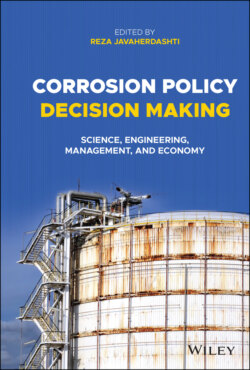Читать книгу Corrosion Policy Decision Making - Группа авторов - Страница 23
2.2.3 Electrical Treatment
ОглавлениеCP is based on reversing the anodic reaction(s) by returning the electrons liberated via anodic reactions back to the metal. This feature of CP can be schematically shown in Figure 2.7. As the figure shows, essential elements of CP are to control electron release via anodic reactions, that is via corrosion, are to be controlled by supplying electrons by either sacrificial anode CP technology or impressed current CP. It is possible to also mix the two methods to make the electron pool available to the object to be protected even more powerful. In addition, based on Pourbaix diagrams, CP “pulls down” the corrosion potential toward more negative potentials, thus bringing the whole reaction to where the atom of the metal remains an atom and not an ion. This way, CP also serves to protect the metal against corrosion.
CP, like any other technology, has its own advantages and disadvantages. The list of these advantages and disadvantages can be too lengthy and we see no need to mention them here. However it is important to note that installing CP systems near metallic objects (above ground or underground) without applying required insulation as well not considering telluric effects on CP systems may actually decrease the workability of such systems. In addition, based on the locations these systems are installed, vandalization may also prove to be a serious matter.
Figure 2.7 Conceptualization of the elements of cathodic protection (CP); 1: Sacrificial anode‐galvanic CP, 2: Impressed current CP.
